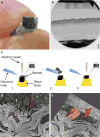Advanced imaging and tissue engineering of the human limbal epithelial stem cell niche
- PMID: 25388395
- PMCID: PMC4398336
- DOI: 10.1007/978-1-4939-1785-3_15
Advanced imaging and tissue engineering of the human limbal epithelial stem cell niche
Abstract
The limbal epithelial stem cell niche provides a unique, physically protective environment in which limbal epithelial stem cells reside in close proximity with accessory cell types and their secreted factors. The use of advanced imaging techniques is described to visualize the niche in three dimensions in native human corneal tissue. In addition, a protocol is provided for the isolation and culture of three different cell types, including human limbal epithelial stem cells from the limbal niche of human donor tissue. Finally, the process of incorporating these cells within plastic compressed collagen constructs to form a tissue-engineered corneal limbus is described and how immunohistochemical techniques may be applied to characterize cell phenotype therein.
Figures







References
-
- Thoft R, Friend J. The X, Y, Z hypothesis of corneal epithelial maintenance. IOVS. 1983;10:1442–1443. - PubMed
-
- Schlotzer-Schrehardt U, Kruse FE. Identification and characterization of limbal stem cells. Exp Eye Res. 2005;81:247–264. - PubMed
-
- Shortt AJ, Secker GA, Munro PM, et al. Characterization of the limbal epithelial stem cell niche: novel imaging techniques permit in vivo observation and targeted biopsy of limbal epithelial stem cells. Stem Cells. 2007;25:1402–1409. - PubMed
MeSH terms
Grants and funding
LinkOut - more resources
Full Text Sources
Other Literature Sources
Medical

